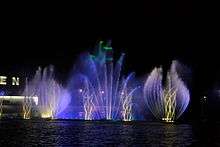Musical fountain
A musical fountain is a type of animated fountain for entertainment purposes that creates an aesthetic design (including three-dimensional images). This is achieved by employing the effects of timed sound waves and timed light (including laser) against water particles. The water refracts and reflects the light, and in doing so, three-dimensional images can be produced.
Installations can be large scale, employing hundreds of water jets and lights, and costing into the millions of dollars, or in smaller household forms, where a budget of one thousand dollars is feasible. Musical features tend to be complex, and require a degree of mechanical, hydraulic, electrical, and electronic components out of view that might be as impressive to its audience as the show itself.


Fountains that are choreographed to music
The earliest musical fountains were played manually by a live operator, who usually controlled pumps or valves and sometimes lights by way of switches on a control panel. Music was almost always live. Later, choreography could be prerecorded on a punched paper card which was scanned by a computer; and even later, it could be recorded on magnetic tape or, in the most modern shows, on a CD along with the music. Even so, the choreography is still usually painstakingly programmed by hand, some types of shows being played live from a control console and connected to a computer that records the operator's actions for later automatic playback. Recent advances in technology provides for unattended automatic choreography that can rival manual programming.
The earliest choreographed musical fountains
The Bodor Fountain
Péter Bodor was a Hungarian gadgeteer and mechanical engineer (born on June 22, 1788, died August 17, 1849) who built a musical or chiming fountain in the Transylvanian town of Marosvásárhely (now Târgu Mureş, Romania) between 1820 and 1822.
His fountain (see pictures here) had a round floor-plan, with two arched stairs on the sides, and a dome roof supported by pillars. The mechanical core was a hydraulic structure driven by the force of water that played popular chimes at every hour. There was a gilded Neptune (or Apollo) statue on the top, that turned round in 24 hours. The fountain was destroyed in 1836 by a snow storm, and was never restored. However, an almost identical copy was built in Budapest's Margit Island in 1936 that did not operated by hydraulic means, but used electricity instead. This latter was partly destroyed during the Second World War, but restored in 1954 and again in 1997. Now it is a tourist attraction that plays music at every hour during the day.
Křižík's light fountain
Křižík's light fountain was built by the Czech inventor and electrical engineer František Křižík in 1891 on the occasion of the World Exhibition in Prague. It became a unique European attraction. The fountain was rebuilt in the 1920s by architect Z. Stašek. The bottom of the fountain plate is equipped with 1300 multicolored reflectors and water circuits composed of more than two kilometers of pipes with almost 3000 nozzles.
The work of F.W. Darlington
Prismatic Fountain, Denver, Colorado - May 30, 1908
"Mayor Robert W. Speer and F.W. Darlington, an engineer with the Denver Interurban Railway, dedicate the new marvel in City Park Lake--The Prismatic Electric Fountain. The Fountain features electric lighting effects that have not been seen before by the public. Eleven columns of brightly coloured light stream through the dramatic changing patterns of water. High in the north tower of the City Park Pavilion, an operator sits at a roll top desk, moving levers to undulate the twelve sets of water features and make the columns of light change color to the sounds of the Denver Municipal Band."
- Denver Municipal Facts--May 22, 1909
F.W. Darlington was a pioneer in electrical fountain control as well as water design.
"Darlington had several signature water feature elements in his fountain designs. The multiple spray rings with "basket-weave" nozzle placement is one that shows up in photographs of several fountains, including some not yet credited to Darlington. The "fan" effect, a complicated triple spray ring with multiple nozzle sizes and angles is yet another water effect seen in several "Electric Fountains."
- (from "Friends of the Electric Fountain" -early pictures available)
Prismatic Fountain, New Orleans, Louisiana - 1915
The Darlington fountain in New Orleans' West End and was likely completed around 1915 or 1916 as the last date on the original drawings are from February 1915. The fountain served as an icon for the West End Park and surrounding yacht clubs and numerous restaurants that were located in the area.
All of Darlington’s fountains required an operator to change the water effects and lighting and were likely used in conjunction with music played by a band or orchestra for special events. It is unknown if the fountain was operated in a static mode when there were no performances or if it was shut off.
Restoration of this fountain is planned by the Friends of West End in New Orleans.
Garfield Park, Indianapolis, Indiana - 1916
In 1915, the new greenhouses and conservatory were built. The dedication of the Sunken Garden took place October 29, 1916. In 1916, Darlington was hired to design and build the fountains at the east end of the Sunken Garden. The fountains were the first in the country to be equipped with the mechanics that allowed the changing of the spray and displayed lights, according to the season and holiday. For Memorial Day, the fountain's lights were alight with red, white, and blue, and on other days, gold and white. Today, the fountains are still an attraction for visitors. This fountain was restored by The Fountain People in 1997 and with a musical control system by Atlantic Fountains in 2003.
Pool of Industry, 1939 New York World's Fair
An early notable example of a musical fountain choreographed live was the Pool of Industry at the 1939 New York World Fair, where three operators controlled the fountain, guided by a paper program that unscrolled under a glass window like the paper roll of a player piano - rather than controlling the effects directly like a piano roll, it was marked with commands that told the operators when to push the buttons and throw the switches. This fountain was more than just water and lights, however. Besides 3 million watts of lights and a gigantic pool containing 1,400 water nozzles, there were over 400 gas jets with a mechanism that caused colored flames and fireworks were shot from over 350 launchers, creating a nighttime spectacle on a grand scale. Music was played live by the fair's band and broadcast by large speakers to the areas surrounding the display. The updated show displayed at the same fairgrounds in 1964 lacked the colored flames but used punched cards for the choreography, had prerecorded music, and utilized the then-revolutionary system of dichroic light filtering (developed by Bausch and Lomb for the fountain) which now allowed a dark colored lens and a light colored lens to produce the same brightness of light. It was by this process that 700,000 watts of light produced over 3 megacandelas. This show also had single lights with multiple sliding color filters for mixing colors, and arrays of nozzles that could be adjusted, their direction changed by hydraulic or pneumatic actuators.
Later water fountains
The Dancing Waters style of water show is a linear display of pumps and lights. In the United States, similar fountains are the Musical Waters. Musical Waters shows use the basic Dancing Waters mechanics. The fountains use single-speed pumps and do not offer variable water heights, and the revolving nozzles are not present since the Dancing Waters design having been prone to jamming. Despite lacking the rotating nozzles that usually define this type of show, the Musical Waters shows are one of the few of this kind that still retain most of the simple elegance that defined Otto Przystawic's first fountains, including the visual attraction of the human element with live "fountaineers" controlling the effects.
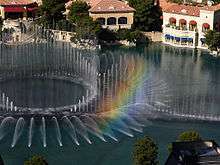
Other United States based companies such as WET (Water Entertainment Technologies), Fontana Fountains, Atlantic Fountains, Fountain People, Formosa Fountains, Hall Fountains, and Waterworks International have built fully computer controlled musical fountains since 1980. These include two to six meter wide systems available to the homeowner as well as large corporate, municipal and show fountains in excess of fifty meters in length—and in the case of WET's Fountains of Bellagio, 9 acres (3.6 ha) in size. These include proportional, interactive and audio spectral control that bring musical fountains to a wide audience. Fountain shapes are not limited to linear layout stage shows but include geometric and freeform shapes as well. Moreover, latest technology allows the construction of Floating watershows. Fontana Fountains first introduced the use of Stainless Steel floaters allowing bigger water show applications even in coasts and lakes.
Manufacturers in the Near and Far East, in places such as India and Pakistan, also produce musical fountains. Many of them have updated the look with individually servomotor-controlled nozzles, large water screens on which video can be projected, and laser effects. Shows are built not only in the standard linear form, but in circular, semicircular and oblong shapes, in multiple pools, and many other layouts. In many places in India, a musical fountain is a must-have attraction for any city, and there will often be at least one local company ready to build them. Firms also rent shows.
International Fountain
.jpg)
Built for the Century 21 Exposition in Seattle in 1963, the International Fountain's original design had changing water and light patterns, with a background of classical music (though the patterns weren't specifically intended to be synched with the music.) The fountain was very large, designed as a concrete bowl around a 'moonscape' of broken limestone, at the center of which was a tiled dome studded with pointy black nozzles. The fountain was not originally designed for interaction but was redesigned in 1996 by WET to make the fountain more inviting, interactive and safe. Switching out the multicolored lights for white, WET added fog nozzles, a ring of their Shooters set into the pavers around the base of the dome, and four large SuperShooters hidden in the upper surface of the dome. The restored fountains behaves as its predecessor did for most of the day, producing changing water patterns as music plays, but it now marks each hour by bringing out other effects, like fog, and performs a choreographed show.
CESC Fountain of Joy, Kolkata
CESC Fountain of Joy[2]—Unique in the subcontinent
India’s most spectacular musical fountain – the CESC Fountain of Joy – was inaugurated in Kolkata, India on 16 October 2012.

According to Mr. Sanjiv Goenka, Chairman, RP-Sanjiv Goenka Group, “The CESC Fountain of Joy is a small gift from the Power Company which has been serving consumers in this area since 1899.” Mr. Goenka recalled, “During the Calcutta-300 Celebrations, Mr. R P Goenka, Chairman, CESC, decided to gift a musical fountain to the city which was inaugurated in the Maidan in 1991. He added " The new fountain will once again be a major attraction and rejuvenate the evenings for both Kolkatans and touristsThe CESC Fountain of Joy which was inaugurated at the same site just before the Durga Pujas, is far more spectacular both in terms of technology and visual effect.”[3]
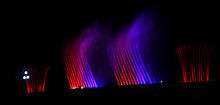

This musical fountain is unique[4] & has 150 channels available for water and light effects – old fountain had 20 channels for water.[5] The concept of three-tier fountain pool, with musical fountain in the upper pool surrounded by architectural and dynamic fountains in the intermediate and lower pools, is quite unique in this subcontinent.
The CESC Fountain of Joy has a centre-fed circular water screen of 6 metre height and 18 metre width. In the upper pool, the CESC Fountain of Joy will have 99 water effects, while the intermediate pool will have 20 water effects and another 30 special water effects in the lower pool. There will be a large water cascading area – more than 80 metre long from upper pool to the intermediate pool.
The CESC Fountain of Joy comes with an enormous number of lights as also LED and PAR lamps, as also high watt reflectors, capable of constantly changing the colours to make the fountain attractive and eye-catching.
According to CESC sources, the Fountain of Joy is integrated with ultra-fast technology, in which water effects will be controlled by the pneumatically assisted solenoid valves, capable of opening and shutting 12 times in a second, thereby resulting in water shooting in air at a spectacular speed.
According to Mr. Sanjiv Goenka, “The inspiration for creating the new CESC Fountain of Joy in the Maidan comes from Chief Minister, Smt Mamata Banerjee, who is so keen to turn Kolkata into a beautiful megapolis.”
The estimated cost is around Rs. 3 crore.
Fountains of Bellagio Hotel
.ogv.jpg)
WET (Water Entertainment Technologies) also designed the Fountains of Bellagio in Las Vegas, which are set in a man-made lake 1,000 feet (300 m) long with an area of 9 acres (3.6 ha). The fountain is formed as a pair of large concentric rings and a long, curved arc, and two smaller circles are attached to the arc near each end. Shooters outline all aspects of the layout, allowing for the arc and circles to rise as columns and curtains of water, as well as providing high-speed chase sequences. Re-engineered HyperShooters fire jets nearly 240 feet (73 m) into the air, and more recently added ExtremeShooters are capable of reaching heights of 500 feet (150 m). Needing a better way to define smoother passages of music, WET engineers developed the Oarsman nozzle, a robotic water jet that can be moved 120 degrees from side to side, to front and back, grouped with a pod of lights that follow the water stream. With the direction, water height, and light of every Oarsman controllable independently from every other Oarsman, a nearly infinite variety of patterns can be created on the lake. A fog generating device rises from beneath the water to blanket the entire lake with fog, and about 4000 individually controllable underwater lights follow the water patterns' precise movements, sparkling on the water or glowing through the fog. Performing to everything from opera to classical to Broadway to pop, the Fountains of Bellagio run every day on the half-hour, and every quarter-hour during the evening. A team of dive-certified engineers is on-site at all times, maintaining the fountain's complex mechanical, electrical and hydraulic systems.
Despite the scale of such shows as the Fountains of Bellagio, these shows must still be programmed and choreographed by hand. Computers aid the process, but engineers must still spend weeks or months on each new performance before it is ready to be placed in rotation with the other shows.
Branson Landing
Branson Landing located in Branson, Missouri features a picturesque boardwalk along the Taneycomo Lakefront. The Landing's center attraction is the Town Square, which is home to a $7.5 million choreographed water attraction designed by WET. The fountains at Branson Landing include dancing and blasting water shooters, blasting water up to 125 feet (38 m) in the air, fire, light and music.
Grand Haven
One other notable fountain of the choreographed type is the Grand Haven Musical Fountain in Grand Haven, Michigan. Built in 1962 by volunteers and designed by a local engineer, this fountain was based on a Przystawic show seen in Germany and was the largest musical fountain in the world when it was built. The display comprises a small number of water formations grouped in odd and even segments, with the same formations on each. Augmented by curtains of water at the back and front, a large fanlike array called the Peacock, and three fire hose nozzles - one placed vertically in the center, and the others aimed at an angle from each end - the show produces a simple Dancing Waters style display. Colored lights are arrayed along the front of the fountain in individually controllable groups in red, blue, amber and white, and the back curtain and Peacock sprays have their own lights - green and yellow for the back curtain, and two sets each red, blue and amber for the Peacock. In addition, nozzles called "sweeps" provide the moving effects, swaying side-to-side. A patented drive mechanism allows each pair of sweeps to follow or oppose each other in direction of movement, to move along long or short paths, and to move at any of three speeds, allowing the moving water to follow nearly any kind of music. The original show used punched paper cards, though computers control the new system. The nozzles and pumps have never been changed, only cleaned and cared-for; and shows must still be programmed by hand. Even with the simplest of the many programs used to create shows for this fountain, choreographing one three-minute song can take anywhere from two to four hours. The Grand Haven Musical Fountain still performs nightly, and is viewable from a grandstand on the waterfront in Grand Haven.
Kangwon Land Multimedia Fountain
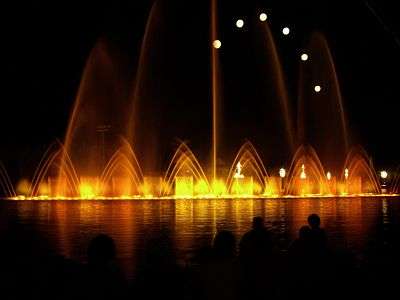
Multimedia Fountain Kangwon Land was opened in in August 2007. It is considered Asia’s largest musical fountain.[6] Multimedia system consists of 180 m water fountains, water screen, video, light, 12 multi-coloured fire units, and laser. The Magical Box multimedia show consists of the big cube system and the fountain. In combination with the fountain during daylight hours the box appears mirrored, but at night it is illuminated to reveal its interior. At night a globe can be seen, some 20 meters in diameter. The special lighting effects give the impression that the globe is rotating and displays the five continents of the world.
Inside the globe is the "Dome Cinema". The "Dome Cinema" has a diameter of 18 meters and is used as the projection area. Video images from TV, DVD, or VHS sources are projected directly into the dome. These images fill almost two thirds of the space. As a result of the various depths of the room, a new laser video system is used to ensure that the images are not distorted. Outside the "Miracle World Box" is the largest fully automatic screen (24 m x 24 m) in the world! Lighting effects, laser projections and synchronized choreographies ensure a unique and unforgettable experience. All of the technology used in and around the "Miracle World Box" was designed, developed and installed by Emotion Media Factory.
Dubai
The largest musical fountain project in the world is the Dubai Fountain. It spans on a 30-acre manmade Burj Khalifa Lake. Designed by WET Design, the California-based company responsible for the fountains at the Bellagio Hotel Lake in Las Vegas. It includes 6,600 lights, 25 colored projectors, fog, and fire. It is 275 m (902 ft) long and shoots water 150 m (490 ft) into the air (equivalent to a 50-story building), accompanied by a range of classical to contemporary Arabic and world music. It was built at a cost of 218 million Dollars. The fountain was formally opened by Sheikh Mohammed bin Rashid Al Maktoum on May 8, 2009, along with the Dubai Mall. Situated in front of the Burj Khalifa, it is best viewed by the public from the Souk al Bahar or The Dubai Mall.
Disney's World of Color
World of Color is a new nighttime show at Disney California Adventure Park, part of the Disneyland Resort in Anaheim, California. The entire show cost $75,000,000 USD to design, manufacture and build. The process of assembling, installing, and testing the show's numerous components and equipment in Paradise Bay spanned a period of approximately 15 months. It premiered on Friday June 11, 2010 as part of "Summer Nightastic!". Conceived by VP Parades and Spectaculars, Steve Davison and designed by Walt Disney Creative Entertainment, the show has more than 1,200 fountains and includes lights, water, fire, fog, and lasers, with high-definition projections on mist screens.
Disney Dreams!
Disney Dreams! is the new show at Disneyland Paris, based on Peter Pan's shadow story. It includes HD projections onto the castle, with pyrotechnics, synchronized fireworks ; water screens and fountains were provided by the French company Aquatique Show International. The project took 18 months to be entirely built, including tests and changes, and cost €10,000,000 (~$13,000,000). It has been a daily show since April 2012, and modifications were added for the first anniversary: two new scenes from The Lion King and Brave. From November 10, 2013 to January 6, 2014 a new show remplaces it: Disney Dreams! of Christmas.
Opryland Hotel Delta Fountain
Located indoors in Nashville, Tennessee under a glass dome at the Gaylord Opryland Resort & Convention Center, this musical fountain features an 85-foot high center geyser surrounded by 68 vertical and 28 arching jets, each with its own RGB LED fixture, plus a fog system and 5 articulating color theatrical lights from above. The sophisticated system was designed by water feature specialists Aquatic Creations, Inc., and plays original music shows choreographed by H2Oarts.com, both of California. The Delta fountain is on a deck rather than in a basin, so it is possible to experience close enough to get lightly misted.
Blackpool Pleasure beach fountains
The Blackpool fountains, created by French company Aquatique Show International, are located at a well known theme park Blackpool Pleasure beach UK. The fountains dance every 30 minutes to a wide range of music. They opened in 2009 letting people run through them. In 2010 they stopped peopled going in them due to health and safety so now they have security guards when the show is on round the fountain. The fountain has 25 jets which can shoot up to 100 ft.
Multimedia fountain Roshen
Multimedia fountain Roshen is located in Vinnytsia, a city in west-central Ukraine, located on the banks of the Southern Buh. Built in 2011 it is considered as one of the largest floating fountains in Europe.[7] It is the major multimedia attraction in the city.
The multimedia shows are combining water effects (fountain), music, lasers and 3D projection on the water screen. For the fountain shows the super powerful LED lights are used allowing applying very bright and showy backlighting resulting in various picturesque effects. Despite other fountains in Ukraine, Roshen multimedia fountain has moving particles reaching verticity due to which the water spring angle is changing dynamically. The sound power of the audio system is 3840 Watt. The height of the central spring reaches 65–70 metres, the projection screen dimension is around 16 metres height and 45 metres width, and the frontal water dispersion constitutes 140 metres. The project design and development was performed by Emotion Media Factory.
Aquanura at the Efteling
Opened in May 2012, Aquanura boasts being the largest water fountain show in Europa and the third largest in the world. It was built on a lagoon near the main entrance of the Efteling, one of Europe's oldest and largest theme parks. Aquanura means "water frogs" and tells the story of The Frog Prince by the Brothers Grimm in a spectacle of water, music, lights and fire. The water fountain was designed and built by WET and features over 200 brightly colored fountains that come to live in a 12-minute-show each day. The show premiered for the 60th anniversary of the theme park and can be seen daily. It is included in the entrance price to the Efteling, however during the summer, separate tickets are sold just to be able to see Aquanura.
Before Aquanura opened, the Efteling had an indoor musical fountain ('waterorgan'). It used to be hand-operated, with pedals and levers, but was later automated. When it opened in 1966, it had live music, but as of 1979, a recording was used. The waterorgan was put out of operation in August 2010, its venue being reused as a studio for a children's television program. It is not clear whether the installation has only been covered up temporarily, or if it has been permanently removed.
Fully automated musical fountains
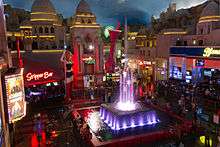
While all pre-programmed musical fountain shows involve computerized show control systems, the use of computer technology to spontaneously "self-choreograph" a fountain to random musical input is novel. Possibly the most sophisticated full-scale implementations in use are at the Miracle Mile Shops in Las Vegas, Washington Park (Cincinnati, Ohio), and Washington Harbour in the District of Columbia, using a system developed by H2Oarts.com. Unlike conventional musical fountains, which must be manually pre-programmed moment-to-moment, the H2Oarts' Musical Water Feature Automation System uses the venue's own live background music to animate the water and lights in real time. Beyond basic light organ-style responses to loudness, bass, and treble, H2Oarts employs rhythm, dynamic range, transient (acoustics), and other subtler components of music to control water and light.
External links
| Wikimedia Commons has media related to Musical fountains. |
- India’s Largest Dancing Musical Fountain
- How to make a dancing fountain
- Videos of automated musical fountains.
- Drawing and explanation of Musical fountain engineering.
- Flowmaster Jopic - Musical fountains
- ↑ http://www.fountainroshen.com/en/o-fontane/
- ↑ Wikimapia (October 6, 2012). "Fountain of Joy (KOLKATA (GREATER KOLKATA AREA))". Wikimapia. Retrieved October 19, 2012.
- ↑ "Fountain of Joy to spring back to life". The Times Of India. October 6, 2012. Retrieved October 19, 2012.
- ↑ Yahoo (October 6, 2012). "Fountain comeback by Puja". Yahoo News. Retrieved October 19, 2012.
- ↑ timesofnews (October 6, 2012). "Fountain of Joy to spring back to life". Times Of News. Retrieved October 19, 2012.
- ↑ http://www.thesouthkoreatravelguide.com/gangwon-do/gohan/high-one-resort_attraction-review.html
- ↑ "Roshen Fountain in Vinnitsa was opened! :: Confectionery Corporation ROSHEN". roshen.com. Retrieved 2015-10-25.
